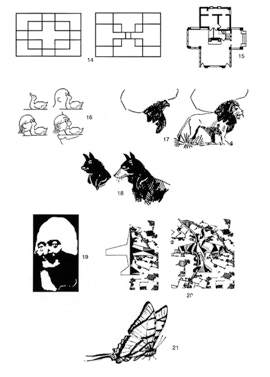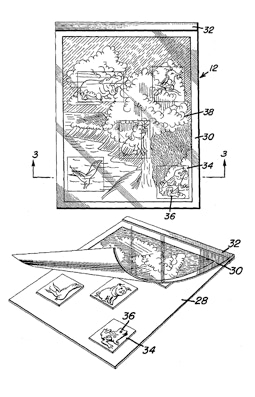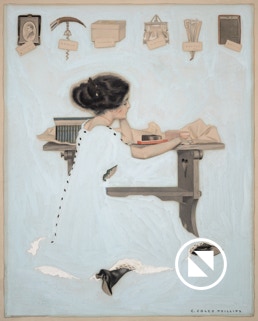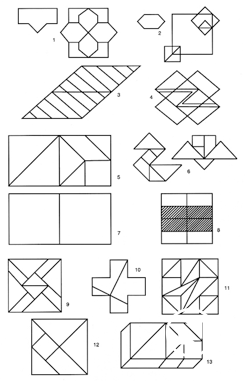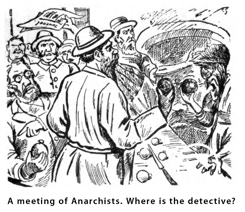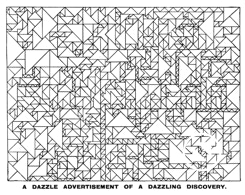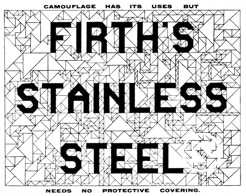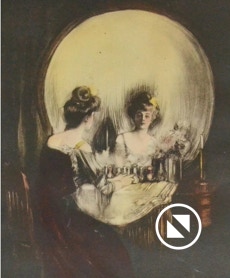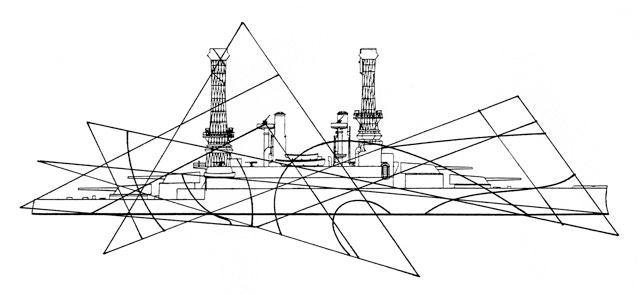
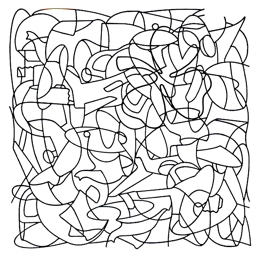
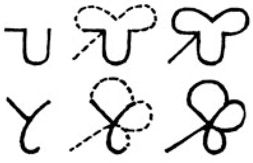
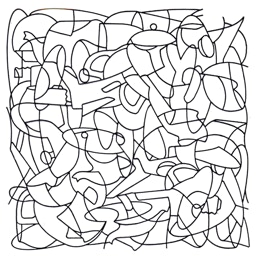
Above Illustration for the cover of Life magazine (January 1910) by Coles Phillips. Along with other illustrators of the same time period, Phillips frequently left out the edges of things, which, in combination with background matching, produced a partial embedding of the figure in the background. At the time, paintings like this were referred to as “fade away girls.”
During World War I, Allied artists searched for ways to produce large numbers of ship camouflage confusion plans, called dazzle-painting. Ideally, no two ships would wear the same camouflage scheme, and designs on the port and starboard sides would also differ substantially. At the top of this page is a hypothetical dazzle camouflage scheme that I created in 1981 to show how a ship might be confusedly broken up by superimposing on it a meaningless linear plan, much like Gottschaldt’s embedded figure diagrams.
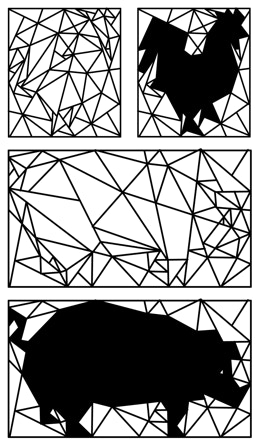
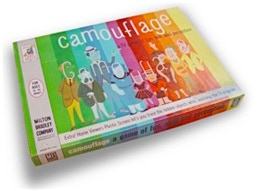
Salvador Dali—
Every Saturday [as a child] I received a juvenile publication to which my father had subscribed for me. Its final page was always devoted to a puzzle picture. This would present, for instance, a forest and a hunter. In the tangled underbrush of the forest the artist had cleverly concealed a rabbit; the problem was to find it. Or, again, a doll must be discovered, lost by a child in an apparently empty room. My father would bring me the puzzle, and what was his astonishment to see me find, not one but two, three or four rabbits, not a single doll but several—and never the one which the artist had meant to conceal.
In the American West, it was common among livestock thieves to change the brands on stolen cattle, by embedding the old brand in a new more complex symbol. Here are two examples. At the left of the top row is the original brand for cattle belonging to the 7U. By adding a couple of simple shapes, it was changed into a three-leaf clover, as shown on the right. In the bottom row, a Y6 brand has been camouflaged in another clover-like branding mark. Given the difficulty of removing tattoos, it is common among tattoo artists to use the same procedure. Instead of removing the old tattoo, they simply design a second tattoo in which to embed the original one. For more information about altered cattle brands, see Barry Scoree, “The Art of Forging Cattle Brands” in The Early Sunset Magazine (April 1927), and Emerson Hough, The Story of the Cowboy (Literature House, Gregg Press), pp. 294-297.
In a 1961 television game show called Camouflage, an all but identical system was used to hide simple line drawings in a maze of meaningless lines. In the drawing at the bottom, can you find the clover?
Hidden figures had also long been used in art, as in this famous horse and rider embedded in the clouds in Andrea Mantegna’s portrayal of St Sebastian (c1459).
Author’s diagrams. Figures 1 through 13. See captions at end of article.
Embedded figures are nothing new. They were widely used for amusement long belong the Gestalt psychologists. Above, for example, are two “puzzle pictures” that appeared in newspapers at the turn of the century, when Cubism was being debated. Typically, the unfilled line drawing would appear in an issue of the newspaper, and the readers would be challenged to “find the Cubist rooster” or “find the Cubist pig” and so on. The answer (showing the black silhouette) would then be revealed the following week.
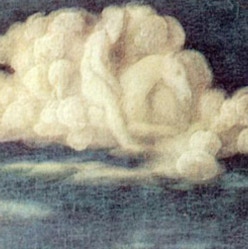
Above is one example of a picture-puzzle that appeared in popular magazines at the end of the 19th century. In the right portion of the picture, the detective’s head is embedded in the background.
Above are two stages of a printed advertisement for Firth’s Stainless Steel. They appeared in newspapers late in WWI, at a time when people were talking about the resemblance of Cubism to dazzle ship camouflage. Like the Cubist animal puzzles mentioned earlier, these were published separately and in sequential issues. The first one might be published several times, without explanation, to heighten curiosity. And then, the punchline followed, revealing that the answer was a cleverly hidden promotion of Firth.
Author’s diagrams. Figures 14 through 21. See captions at end of article.
Drawings submitted for US Patent No 2670961, titled “puzzle” by Charles E. Winters (1954). When a high density drawing (printed on a transparent overlay) is overlayed on simple drawings on a board, those drawings become camouflaged.
an essay by
an essay published initially in
Gestalt Theory: Journal of the GTA, Vol 22 No 2 (2000), pp. 97-106. Copyright © by Roy R. Behrens.
Revisiting
Gottschaldt
Embedded Figures
in Art, Architecture
and Design
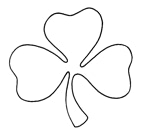
In 1920, the Psychological Institute at the University of Berlin moved to the abandoned Imperial Palace, about a half-mile from the university. Its size and budget were increased, and Wolfgang Köhler, one of the founders of Gestalt psychology, was appointed the new director (Ash, 1995, p. 205).
Under Kohler’s supervision, along with his colleagues Max Wertheimer and Kurt Lewin, the graduate students at the Institute designed and carried out their own psychological research, while serving as subjects for the experiments of fellow students. The results of their work were later published in scientific journals under the joint authorship of both student and professor (Arnheim, 1984).
Among the students was Kurt Gottschaldt (1902-1991), who completed his dissertation in 1926, and was then hired as a paid assistant until his dismissal in 1929 (Ash, 1995, p. 354). In the literature of Gestalt theory, Gottschaldt is often mentioned because of his research of past experience in relation to the perception of game-like visual puzzles called embedded figures, in which smaller, simpler shapes are hidden within larger, more complex designs.
In his now-famous experiment, Gottschaldt showed five simple geometric figures to two subject groups for one second each, instructing the subjects to memorize the figures carefully enough that they could draw them later. These figures were shown to the one group only three times, and to the second group 520 times. Both groups were then introduced to a series of new, more complex drawings, for two seconds each, into which (unknown to the subjects) one of the earlier figures had been integrated (Figures 1-4). Initially, in both groups, fewer than 10 per cent of the subjects suspected the presence of an embedded figure; and even when instructed to search for it, only about 30 per cent were able to detect the original figure (Gottschaldt, 1926).
Over the years, Gottschaldt’s embedded figure research has frequently been cited by psychologists and other scientists, and the issues most often debated have been the influence of experience on perception, the extent to which wholes may influence their parts, and the nature of problem-solving. In this essay, I would like to discuss embedded figures from a somewhat different viewpoint, from that of an artist, and to highlight a few of the principal ways in which this same phenomenon has been used by artists, architects and designers.
It is conceivable that the figures used in Gottschaldt’s experiment were originated by him, but surely he did not come up with the idea of an embedded figure. It is more likely that comparable figures have been discovered or devised throughout human history, that they are ubiquitous visual events, examples of which can be found in all cultures and time periods.
The geometric figures in Gottschaldt’s experiment are reminiscent of Victorian-era parlor games, referred to by antique collectors as “put-together puzzles.” Among the oldest is the tangram, which was introduced to Europe from Asia in the early 19th century, at which time it was known as the “Chinese puzzle” or “seven clever pieces” (Elffers, 1997; Slocum and Botermans, 1994, p. 2ff). One can easily make a tangram by dividing two adjacent squares into seven geometric parts in a prescribed manner (Figure 5). Any number of games can be played with the pieces, but the customary challenge is to use all seven in arriving at alternative configurations, whether abstract or pictorial (Figure 6).
While the tangram’s origin is unknown, it may be historically tied to a feature of traditional Japanese architecture, the floor mat or tatami (Figure 7). Measuring 3 feet by 6 feet, and comprised of two adjoining squares (identical to an undivided tangram), the tatami was used as the module for the floor plans of traditional Japanese houses. Each house plan was made by arranging such mats in rectangular patterns (Nute, 1993, pp. 43-44).
I know this in part because the tatami (the shape of a domino) is a recurrent motif in the Kamerick Art Building (designed in 1985 by a Des Moines architectural firm). It is the building in which I taught for decades at the University of Northern Iowa in Cedar Falls, Iowa. Throughout that structure, in its windows, handrails, floor tiles, ceiling panels, and mosaic wall coverings, one finds references to tatami proportions (Figure 8).
Like the tatami, the tangram too has been widely imitated. Renditions of it were produced and distributed in Europe and the US during the late 19th century and early 20th century, among them The Elzzup Puzzle (1898), The Square and Cross Puzzle (1913), The Mysterious Cross (1932), and Baffle 1 (1935) (Figures 9-12).
Among the most popular in Germany were Anchor Puzzles, including The Headcracker (Der Kopfzerbrecher, 1891), The Patience Prover (Der Geduldprufer, 1896) and The Pipesmoker (Der Pfeifenracher, 1913). These were apparently first produced about 1884, through the efforts of J.D. Georgens, a friend of Friedrich Froebel (who was the founder of kindergarten and who may have been among the first to use wooden building blocks as educational toys) (see Slocum and Botermans, 1994, p. 6; Brosterman, 1997; Lupton and Miller, 1993). It may be more than coincidence that Froebel began his kindergarten in the 1830s, while an early explicit connection between children’s toys and tangrams was produced at nearly the same time in The Magic of Geometry, a set of blocks in the shape of the parts of a tangram (Brosterman, 1997, p. 55) (Figure 13).
In tangrams as in Froebel blocks, the primary goal is to “put things together,” to create new wholes by repositioning the same set of parts. Conversely, in embedded figure puzzles such as Gottschaldt’s, the goal is to “take things apart,” to unearth a detail from a larger configuration.
The literary equivalent of a put-together puzzle is an anagram, in which alternative words are produced by rearranging the same set of letters (the letters in garden, for example, might become danger, gander or ranged); while the equivalent of an embedded figure is a word search puzzle (the word and, for example, can be extracted from gander). In either case, one faces the same range of challenges because wholes nearly always have synergistic properties (“the whole is greater than [or at least different from] the sum of its parts”), and a part in one context may visibly change when its position is altered: A line by itself on a blank page and the same line as the side of a figure, said Kurt Koffka, are “two different things” (quoted in Ash, 1995, p. 231).
The American architect Frank Lloyd Wright was born in 1867, fifteen years after Froebel’s death and far in advance of the founding of Gestalt psychology. Nevertheless, by his own admission, he was substantially influenced by Froebel blocks (which were given to him by his mother), Japanese woodcut prints, and, very likely, such games as the tangram (Nute, 1993). He was also very much aware of a book titled Composition by Arthur Wesley Dow, Curator of Japanese Paintings and Prints at the Boston Museum of Fine Arts. First published in 1899, that hugely influential book includes geometric diagrams (which Dow called “aesthetic line-ideas”) of tartan-like plans for page or picture layout schemes (Dow, 1997) (Figure 14).
At first glance, the resemblance between Dow’s and Gottschaldt’s diagrams may appear only slight. But their connection becomes more compelling when we learn that a number of Wright’s house plans (the first of which was designed only months after the publication of Composition) were apparently created by his having treated Dow’s drawings as if they were embedded figure diagrams. Wright’s house plans, as architectural historian Kevin Nute has shown, are modified extractions from Dow’s layout diagrams; they are details exhumed from a larger Gestalt (Nute, 1993, pp. 86-98) (Figure 15).
Another Victorian-era practice that may have prompted Wright, Dow and Gottschaldt to become interested in embedded figures is a form of public speaking called a chalk talk (Tarbell, 1924). The term refers not only to a lecture given with the aid of a chalkboard. It also implies a sequential, simply-drawn cartoon in which (to the surprise of the audience) one picture is hidden within another and, as the talk progresses, the first drawing is magically transformed into the second. A duck, for example, may evolve step-by-step into a farmer, a hunter into the hunted, or a prey into its predator (Figures 16-18). Chalk talks were popular in the 1920s (coincident with Gottschaldt’s dissertation), but I recall from childhood that they were still occasionally used by speakers in the 1950s.
Hidden pictures, like those in chalk talks, have long been used in visual art. There is a rider in the clouds in Andrea Mantegna’s painting of St. Sebastian (c. 1460), a face in a rock in a landscape by Albrecht Dürer (c. 1495), and two nuns in a portrait of Voltaire by Salvador Dali (1940) (Figure 19). In Art and Illusion, art historian E.H. Gombrich reproduces a photograph of a prehistoric sculpture on a cave wall in France that appears to have come from the shape of a rock in which the artist saw the embedded figure of a horse. Similarly, Gombrich suggests, constellations might also be regarded as embedded figures in the night sky (Gombrich, 1969, pp. 105-109).
Embedded accidental shapes (or chance images) are mentioned in a famous passage in Leonardo da Vinci’s Treatise on Painting, in which he advises that a sure way to produce new ideas is to “look at certain walls stained with damp, or at stones of uneven color.” If in need of a background while painting, he writes, “You will be able to see in these the likeness of divine landscapes, adorned with mountains, ruins, rocks, woods, great plains, hills and valleys in great variety; and then again you will see there battles and strange figures in violent action, expressions of faces and clothes and an infinity of things which you will be able to reduce to their complete and proper forms. In such walls the same thing happens as in the sound of bells, in whose stroke you may find every named word which you can imagine” (quoted in Gombrich, 1969, p. 188)
Among those who advocated similar techniques were the British artists Alexander Cozens, who wrote a book about the use of accidental ink blots as points of departure, and Aubrey Beardsley, who said of his own method, “I make a blot upon the paper and begin to shove the ink about and something comes” (Gombrich, 1969). Even more astonishing are the experiments of the French novelist Victor Hugo, who made drawings and paintings not only from ink blots, but from soot, black coffee, mulberry juice, burned onion, cigar ash, fingerprints, fingernails, matchsticks, stencils, sprays of water, lace and cloth impressions. He even signed and dated stones (Rodari, 1998).
Chance images are not always desirable. There is a wonderful story about Pablo Picasso and Georges Braque, the co-founders of Cubism, for example, who were painting in ways that were largely abstract. One day, as Picasso was looking at Braque’s latest painting, “he became aware that there was a squirrel in the picture, and pointed it out to Braque, who was rather abashed at this discovery. The next day Braque showed him the picture again, after reworking it to get rid of the squirrel, but Picasso insisted that he still saw it, and it took another reworking to banish the animal for good” (Jansen, 1973, p. 352).
Embedded figures such as Gottschaldt’s, wrote Köhler in 1947 in Gestalt Psychology, are comparable to “the puzzle-pictures which years ago amused the readers of magazines…” They rely on the same principles as camouflage, he continued, which in modern wars has been used “to make objects such as guns, cars, boats, etc., disappear by painting upon these things irregular designs, the parts of which are likely to form units with parts of their environment” (Köhler, 1947, pp. 92-93).
A step-by-step procedure for concealing an object in its surroundings was demonstrated in 1942 by American artist Eric Sloane in Camouflage Simplified in a section on “The Disruptive Pattern” (Sloane, 1942). By cutting up the object (a building, airplane or whatever) with lines and shapes that contradict (are “not in harmony with”) the attributes of the figure, a camouflage artist can prevent it from being seen as a single, segregated object, and, at the same time, can blur the distinctions between the object and its surroundings (Figure 20).
The result of course is a variety of embedded figure, an effect that was given the suitable name of “coincident disruptive coloration” by British zoologist and scientific illustrator Hugh B. Cott, who was also a camouflage artist in World War II. On the one hand such forms are disruptive, said Cott, because “they appear to break up what is really a continuous surface” (the figure); while, at the same time, they are also coincident because they “unite [visually] what are actually discontinuous surfaces” (the figure and ground) (Cott, 1940, p. 70). As Cott illustrates, coincident disruption in nature occurs not only between a figure and its surroundings; it also takes place in relations among distinct regions of the same figure, as shown by the misleading bands that result when a frog’s legs are folded up or a butterfly’s wings are unfurled and aligned (Figure 21).
During World Wars I and II, hundreds of soldiers (French, British, German, American, Russian and others) who had been artists in civilian life were assigned to camouflage (Behrens, 1998a). What enabled those artists to be well-suited for concealing objects (or at least to assume that they might be) was their understanding of innate grouping tendencies or “laws of visual organization” (similarity, proximity, continuity and closure) that Wertheimer proposed in a paper he wrote in 1923. Titled “Untersuchungen zur Lehre von der Gestalt,” that essay was fondly referred to among students at the Berlin Psychological Institute as Wertheimer’s Punktarbeit or “dot paper” because its visual examples were abstract patterns made of dots (Arnheim, 2000). It is those same grouping tendencies or unit-forming factors (a term borrowed from Fritz Heider) that determine the ease or the challenge with which one can solve an embedded figure problem (cf. Behrens, 1998c).
As the leading proponent of Prairie School architecture, one of Frank Lloyd Wright’s main goals was the “destruction of the [impenetrable architectural] box,” which he did by embedding his buildings within their physical surroundings: No house should ever be on a hill, he said; instead, it should be of a hill. The purpose of an architectural structure, said Wright, is “to afford protection against storm or heat,” but also “to bring the outside world into the house, and let the inside of the house go outside” (Nute, 1993, p. 62).
Just as camouflaged objects and Wright’s buildings may remind us of embedded figures, the same is also often true of artworks and the page layouts of graphic designers. One reason for this is that skilled artists and designers, like architects, make use of the interconnections between a figure and its background, a text and the page it resides in, or a building and its building site, for the purpose of what is traditionally called “esthetic unity.” In a well-designed house in its setting, said Wright, “everything has a related articulation in relation to the whole and all belongs together; looks well together because all are speaking the same language” (cf. Behrens, 1998b).
A further reason why art, architecture and design tend to resemble Gottschaldt’s embedded figure puzzles is that the finest, most lucid examples combine clarity with implicitness. They provoke closure—the act of completing an incomplete form in the very process of perceiving it—providing for what Gombrich calls “the beholder’s share” (Gombrich, 1969, p. 183ff), and for which Arthur Koestler coined the term “infolding,” the purpose of which “is not to obscure the message, but to make it more luminous by compelling the recipient to work it out by himself—to re-create it” (Koestler, 1964, p. 337).
ILLUSTRATION CAPTIONS
Figs. 1-4: Examples of Gottschaldt’s embedded figures.
Fig. 5: Tangram, showing its standard divisions.
Fig. 6: Recombined tangram pieces (3 solutions).
Fig. 7: Tatami architectural module.
Fig. 8: Architectural motif from the Kamerick Art Building, University of Northern Iowa, USA.
Fig. 9: Elzzup puzzle (c. 1898).
Fig. 10: Square and Cross puzzle (c. 1913).
Fig. 11: Mysterious Cross puzzle (c. 1932).
Fig. 12: Baffle puzzle (c. 1935).
Fig. 13: The Magic of Geometry puzzle (c. 1830s).
Fig. 14: Esthetic line-ideas from Arthur Wesley Dow’s Composition (1899).
Fig. 15: Comparison of one of Dow’s “esthetic line-ideas” with the plan of Frank Lloyd Wright’s design for the Charles S. Ross house in Lake Delavan, Wisconsin USA (1902). Based on a diagram by Kevin Nute (Nute, 1993, p. 89).
Figs. 16-18: Chalk talk drawings by Harlan Tarbell (Tarbell, 1924).
Fig. 19: Two nuns in a portrait of Voltaire, redrawn from a painting by Salvador Dali, titled Slave Market with Disappearing Bust of Voltaire (1940).
Fig. 20: Disruptive camouflage applied to an airplane. Based on a diagram by Eric Sloane (Sloane, 1942).
Fig. 21: Coincident disruptive patterning in the wings of a swallowtail butterfly.
REFERENCES
Ash, M., Gestalt Psychology in German Culture, 1890-1967. Cambridge, UK: Cambridge University Press.
Arnheim, R. (1984). “My Life in the Art World,” brochure resulting from a talk presented at the School of Art, University of Michigan, Ann Arbor, on 8 February.
Arnheim, R. (2000). Letter to the author dated 18 January.
Behrens, R.R. (1998a). “On Max Wertheimer and Pablo Picasso: Gestalt Theory, Cubism and Camouflage” in Gestalt Theory, Vol. 20 No. 2 (June), pp. 111-118.
Behrens, R.R. (1998b). “Little Houses on the Prairie: Grant Wood and Frank Lloyd Wright” in Tractor: Iowa Arts and Culture (Summer), pp. 4-6.
Behrens, R.R. (1998c). “Art, Design and Gestalt Theory” in Leonardo, Vol. 31 No. 4, pp. 299-303.
Behrens, R.R. (2002). False Colors: Art, Design and Modern Camouflage. Dysart IA: Bobolink Books.
Behrens, R.R. (2009). Camoupedia: A Compendium of Research on Art, Architecture and Camouflage. Dysart IA: Bobolink Books.
Behrens, R.R., ed. (2012). Ship Shape: A Dazzle Camouflage Sourcebook. Dysart IA: Bobolink Books.
Behrens, R.R. (2016). Frank Lloyd Wright and Mason City: Architectural Heart of the Prairie. Charleston SC: History Press.
Brosterman, Norman (1997). Inventing Kindergarten. New York: Harry N. Abrams.
Cott, H.B. (1940). Adaptive Coloration in Animals. London: Methuen and Company.
Dow, A.W. (1997) [reprint of 1920 edition; originally published in 1899]. Composition. Berkeley: University of California Press.
Elffers, J. (1997). Tangram: The Ancient Chinese Puzzle. New York: Stewart Tabori and Chang.
Gombrich, E.H. (1969). Art and Illusion: A Study of the Psychology of Pictorial Representation. Princeton NJ: Princeton University Press.
Gottschaldt, K. (1966). “The Influence of Past Experience on the Perception of Figures” [1926] in M.D. Vernon, editor, Experiments in Visual Perception. Baltimore MD: Penguin Books.
Janson, H.W. (1973). “Chance Images” in Philip P. Wiener, editor, Dictionary of the History of Ideas, Vol. 1. New York: Charles Scribner’s Sons.
Koestler, A. (1964). The Act of Creation. New York: Macmillan.
Kohler, W. (1947). Gestalt Psychology. New York: New American Library.
Lupton, E. and J.A. Miller, editors (1993). The ABC’s of [triangle square circle]: The Bauhaus and Design Theory. New York: Princeton Architectural Press.
Nute, K. (1993). Frank Lloyd Wright and Japan. New York: Van Nostrand Reinhold.
Rodari, F. et al. (1998). Shadows of a Hand: The Drawings of Victor Hugo. New York: The Drawing Center, and Merrell Holbertson, London.
Sloane, E. (1942). Camouflage Simplified. New York: Devin-Adair.
Slocum, J. and J. Botermans (1994). The Book of Ingenious and Diabolical Puzzles. New York: Times Books.
Tarbell, H. (1924). How To Chalk Talk. Chicago: T.S. Denison.
Zerubavel, E. (1991). The Fine Line: Making Distinctions in Everyday Life. Chicago: University of Chicago Press.
Zerubavel, E. (2015). Hidden in Plain Sight: The Social Structure of Irrelevance. New York: Oxford University Press.
•••
© Roy R. Behrens
Click on images to enlarge
Above Among the best known examples of an embedded figure is this colored drawing by C. Allan Gilbert, titled All Is Vanity, which became widely known when it appeared in Life magazine in 1902. Embedded figures are also commonly called “camouflaged figures,” so it may not be surprising to find that Gilbert designed ship camouflage during World War I.
“By the mid-1890s poster art and book design turned pictorial surfaces into a maze…Design blurred the outlines that commonly give recognizable shapes to unique objects or…that distinguish between multiple planes. Everything within the grip of the design became part of the same boldly flattened-out field, wonderful to look at, somewhat a puzzle to read.”
Martha Banta, Imaging American Women: Ideas and Ideals in Cultural History. New York: Columbia University Press, 1987.
